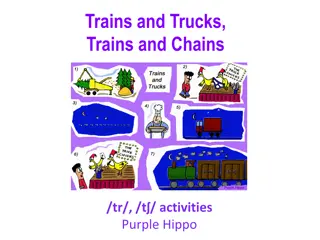
Understanding Network Layer in Communication Systems
The network layer plays a crucial role in routing packets from source to destination across different networks. It handles logical addressing, routing decisions, and facilitates end-to-end delivery. Learn more about the network layer's functions in this detailed explanation.
Download Presentation

Please find below an Image/Link to download the presentation.
The content on the website is provided AS IS for your information and personal use only. It may not be sold, licensed, or shared on other websites without obtaining consent from the author. If you encounter any issues during the download, it is possible that the publisher has removed the file from their server.
You are allowed to download the files provided on this website for personal or commercial use, subject to the condition that they are used lawfully. All files are the property of their respective owners.
The content on the website is provided AS IS for your information and personal use only. It may not be sold, licensed, or shared on other websites without obtaining consent from the author.
E N D
Presentation Transcript
Figure (2.7) Hop-to-hop delivery As the figure shows, communication at the data link layer occurs between two adjacent nodes. To send data from A to F, three partial deliveries are made. First, the data link layer at A sends a frame to the data link layer at B (a router). Second, the data link layer at B sends a new frame to the data link layer at E. Finally, the data link layer at E sends a new frame to the data link layer at F. Note that the frames that are exchanged between the three nodes have different values in the headers. The frame from A to B has B as the destination address and A as the source address. The frame from B to E has E as the destination address and B as the source address. The frame from E to F has F as the destination address and E as the source address. The values of the trailers can also be different if error checking includes the header of the frame. Network Layer: - The network layer is responsible for the source-to-destination delivery of a packet, possibly across multiple networks (links). Whereas the data link layer oversees the delivery of the packet between two systems on the same network (links), the network layer ensures that each packet gets from its point of origin to its final destination. If two systems are connected to the same link, there is usually no need for a network layer. However, if the two systems are attached to different networks (links) with connecting devices between the networks (links), there is often a need for the network layer to accomplish source-to- destination delivery. Figure 2.8 shows the relationship of the network layer to the data link and transport layers.
Figure (2.8) Network layer Note: - The network layer is responsible for the delivery of individual packets from the source host to the destination host. Other responsibilities of the network layer include the following:- Logical addressing. The physical addressing implemented by the data link layer handles the addressing problem locally. If a packet passes the network boundary, we need another addressing system to help distinguish the source and destination systems. The network layer adds a header to the packet coming from the upper layer that, among other things, includes the logical addresses of the sender and receiver. We discuss logical addresses later in this chapter. Routing. When independent networks or links are connected to create internetworks (network of networks) or a large network, the connecting devices (called routers or switches) route or switch the packets destination. One of the functions of the network layer is to provide this mechanism. Figure 2.9 illustrates end-to-end delivery by the network layer. to their final Figure (2.9) Source-to-destination delivery
As the figure shows, now we need a source-to-destination delivery. The network layer at A sends the packet to the network layer at B. When the packet arrives at router B, the router makes a decision based on the final destination (F) of the packet. Router B uses its routing table to find that the next hop is router E. The network layer at B, therefore, sends the packet to the network layer at E. The network layer at E, in turn, sends the packet to the network layer at F. Transport Layer:-The transport layer is responsible for process-to-process delivery of the entire message. A process is an application program running on a host. Whereas the network layer oversees source-to- destination delivery of individual packets, it does not recognize any relationship between those packets. It treats each one independently, as though each piece belonged to a separate message, whether or not it does. The transport layer, on the other hand, ensures that the whole message arrives intact and in order, overseeing both error control and flow control at the source-to-destination level. Figure 2.10 shows the relationship of the transport layer to the network and session layers. Figure (2.10) Transport layer Note: -The transport layer is responsible for the delivery of a message from one process to another. Other responsibilities of the transport layer include the following: Service-point addressing. Computers often run several programs at the same time. For this reason, source-to- destination delivery means delivery not only from one computer to the next but also from a specific process (running program) on one computer to a specific process (running program) on the other. transport layer header must therefore include a type of address called a service-point address (or port address). The network layer gets each packet to the correct computer; the transport layer gets the entire message to the correct process on that computer. The Segmentation and reassembly. A message is divided into transmittable segments, with each segment containing a sequence number. These numbers enable the transport layer to reassemble the message correctly upon arriving at the destination and to identify and replace packets that were lost in transmission.
Figure (2.7) Hop-to-hop delivery As the figure shows, communication at the data link layer occurs between two adjacent nodes. To send data from A to F, three partial deliveries are made. First, the data link layer at A sends a frame to the data link layer at B (a router). Second, the data link layer at B sends a new frame to the data link layer at E. Finally, the data link layer at E sends a new frame to the data link layer at F. Note that the frames that are exchanged between the three nodes have different values in the headers. The frame from A to B has B as the destination address and A as the source address. The frame from B to E has E as the destination address and B as the source address. The frame from E to F has F as the destination address and E as the source address. The values of the trailers can also be different if error checking includes the header of the frame. Network Layer: - The network layer is responsible for the source-to-destination delivery of a packet, possibly across multiple networks (links). Whereas the data link layer oversees the delivery of the packet between two systems on the same network (links), the network layer ensures that each packet gets from its point of origin to its final destination. If two systems are connected to the same link, there is usually no need for a network layer. However, if the two systems are attached to different networks (links) with connecting devices between the networks (links), there is often a need for the network layer to accomplish source-to- destination delivery. Figure 2.8 shows the relationship of the network layer to the data link and transport layers.
As the figure shows, now we need a source-to-destination delivery. The network layer at A sends the packet to the network layer at B. When the packet arrives at router B, the router makes a decision based on the final destination (F) of the packet. Router B uses its routing table to find that the next hop is router E. The network layer at B, therefore, sends the packet to the network layer at E. The network layer at E, in turn, sends the packet to the network layer at F. Transport Layer:-The transport layer is responsible for process-to-process delivery of the entire message. A process is an application program running on a host. Whereas the network layer oversees source-to- destination delivery of individual packets, it does not recognize any relationship between those packets. It treats each one independently, as though each piece belonged to a separate message, whether or not it does. The transport layer, on the other hand, ensures that the whole message arrives intact and in order, overseeing both error control and flow control at the source-to-destination level. Figure 2.10 shows the relationship of the transport layer to the network and session layers. Figure (2.10) Transport layer Note: -The transport layer is responsible for the delivery of a message from one process to another. Other responsibilities of the transport layer include the following: Service-point addressing. Computers often run several programs at the same time. For this reason, source-to- destination delivery means delivery not only from one computer to the next but also from a specific process (running program) on one computer to a specific process (running program) on the other. transport layer header must therefore include a type of address called a service-point address (or port address). The network layer gets each packet to the correct computer; the transport layer gets the entire message to the correct process on that computer. The Segmentation and reassembly. A message is divided into transmittable segments, with each segment containing a sequence number. These numbers enable the transport layer to reassemble the message correctly upon arriving at the destination and to identify and replace packets that were lost in transmission.
with the transport layer at the destinationmachine first before delivering the packets. After all the data are transferred,the connection is terminated. Flow control. Like the data link layer, the transport layer is responsible for flowcontrol. However, flow control at this layer is performed end to end rather thanacross a single link. Error control. Like the data link layer, the transport layer is responsible forerror control. However, error control at this layer is performed process-to-processrather than across a single link. Thesending transport layer makes surethat the entire message arrives at the receiving transport layer without error(damage, loss, or duplication). Error correction is usually achieved throughretransmission. Figure 2.11 illustrates process-to-process delivery by the transport layer. Figure (2.11) Reliable process-to-process delivery ofa message Session Layer: - The services provided by the first three layers (physical, data link, and network) are not sufficient for some processes. The session layer is the network dialog controller. It establishes, maintains, and synchronizes the interaction among communicating systems. Note: -The session layer is responsible for dialog control and synchronization. Specific responsibilities of the session layer include the following: Dialog control. The session layer allows two systems to enter into a dialog. between two processes to take place in either half duplex (one way at a time) or full- duplex (two ways at a time) mode. It allows the communication Synchronization. The session layer allows a process to add checkpoints, or synchronization points, to a stream of data. For example, if a system is sending a file of 2000 pages, it is advisable to insert checkpoints after every 100 pages to ensure that each 100-page unit is received and acknowledged independently In this case if a crash happens
Figure (2.12) Session layer Presentation Layer: -The presentation layer is concerned with the syntax and theinformationexchanged between two systems. Figure 2.13 shows the relationship presentationlayer and the application and session layers. semantics of between the Figure (2.13) Presentation layer Note: -The presentation layer is responsible for translation, compression, and encryption. Specific responsibilities of the presentation layer include the following: Translation. The processes (running programs) in two systems are usually exchanging information in the form of character strings, numbers, and so on. The information must be changed to bit streams before being transmitted. Because different computers use different encoding systems, the presentation layer is responsible for interoperability between these different encoding methods. The presentation layer at the sender changes the information from its sender-dependent format into a common format. The presentation layer at the receiving machine changes the common format into its receiver-dependent










